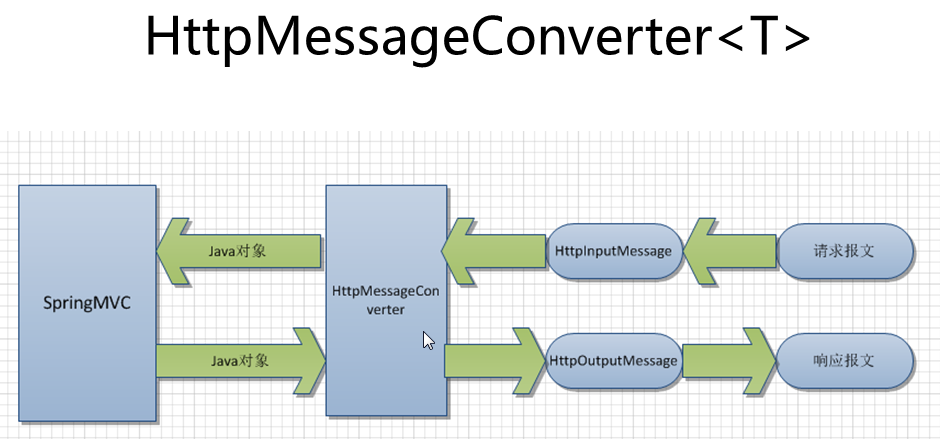一:导入jar包。然后在springmvc.xml中配置上这么一句话
1 <!-- 能支持springmvc更高级的一些功能,JSR303校验,快捷的ajax,处理JSON数据。映射动态请求 --> 2 <mvc:annotation-driven/>
<mvc:annotation-driven /> 会自动注册DefaultAnnotationHandlerMapping与AnnotationMethodHandlerAdapter 两个bean,是spring MVC为@Controllers分发请求所必须的。
并提供了:数据绑定支持,@NumberFormatannotation支持,@DateTimeFormat支持,@Valid支持,读写XML的支持(JAXB),读写JSON的支持(Jackson)。
二:在方法中前面加上这么一个注解:
@ResponseBody
return返回的就是一个JSON的对象。而不是去跳转到页面上。
原理:使用HtppMessageConverter这个类。
这个类负责将请求信息转换成一个对象。将对象输出为响应信息。

简介:
@RequestBody
作用:
i) 该注解用于读取Request请求的body部分数据,使用系统默认配置的HttpMessageConverter进行解析,然后把相应的数据绑定到要返回的对象上;
ii) 再把HttpMessageConverter返回的对象数据绑定到 controller中方法的参数上。
使用时机:
A) GET、POST方式提时, 根据request header Content-Type的值来判断:
- application/x-www-form-urlencoded, 可选(即非必须,因为这种情况的数据@RequestParam, @ModelAttribute也可以处理,当然@RequestBody也能处理);
- multipart/form-data, 不能处理(即使用@RequestBody不能处理这种格式的数据);
- 其他格式, 必须(其他格式包括application/json, application/xml等。这些格式的数据,必须使用@RequestBody来处理);
B) PUT方式提交时, 根据request header Content-Type的值来判断:
- application/x-www-form-urlencoded, 必须;
- multipart/form-data, 不能处理;
- 其他格式, 必须;
说明:request的body部分的数据编码格式由header部分的Content-Type指定;
@ResponseBody
作用:
该注解用于将Controller的方法返回的对象,通过适当的HttpMessageConverter转换为指定格式后,写入到Response对象的body数据区。
使用时机:
返回的数据不是html标签的页面,而是其他某种格式的数据时(如json、xml等)使用;
1 <span style="font-family:Microsoft YaHei;">/** 2 * Strategy interface that specifies a converter that can convert from and to HTTP requests and responses. 3 * 4 * @author Arjen Poutsma 5 * @author Juergen Hoeller 6 * @since 3.0 7 */ 8 public interface HttpMessageConverter<T> { 9 10 /** 11 * Indicates whether the given class can be read by this converter. 12 * @param clazz the class to test for readability 13 * @param mediaType the media type to read, can be {@code null} if not specified. 14 * Typically the value of a {@code Content-Type} header. 15 * @return {@code true} if readable; {@code false} otherwise 16 */ 17 boolean canRead(Class<?> clazz, MediaType mediaType); 18 19 /** 20 * Indicates whether the given class can be written by this converter. 21 * @param clazz the class to test for writability 22 * @param mediaType the media type to write, can be {@code null} if not specified. 23 * Typically the value of an {@code Accept} header. 24 * @return {@code true} if writable; {@code false} otherwise 25 */ 26 boolean canWrite(Class<?> clazz, MediaType mediaType); 27 28 /** 29 * Return the list of {@link MediaType} objects supported by this converter. 30 * @return the list of supported media types 31 */ 32 List<MediaType> getSupportedMediaTypes(); 33 34 /** 35 * Read an object of the given type form the given input message, and returns it. 36 * @param clazz the type of object to return. This type must have previously been passed to the 37 * {@link #canRead canRead} method of this interface, which must have returned {@code true}. 38 * @param inputMessage the HTTP input message to read from 39 * @return the converted object 40 * @throws IOException in case of I/O errors 41 * @throws HttpMessageNotReadableException in case of conversion errors 42 */ 43 T read(Class<? extends T> clazz, HttpInputMessage inputMessage) 44 throws IOException, HttpMessageNotReadableException; 45 46 /** 47 * Write an given object to the given output message. 48 * @param t the object to write to the output message. The type of this object must have previously been 49 * passed to the {@link #canWrite canWrite} method of this interface, which must have returned {@code true}. 50 * @param contentType the content type to use when writing. May be {@code null} to indicate that the 51 * default content type of the converter must be used. If not {@code null}, this media type must have 52 * previously been passed to the {@link #canWrite canWrite} method of this interface, which must have 53 * returned {@code true}. 54 * @param outputMessage the message to write to 55 * @throws IOException in case of I/O errors 56 * @throws HttpMessageNotWritableException in case of conversion errors 57 */ 58 void write(T t, MediaType contentType, HttpOutputMessage outputMessage) 59 throws IOException, HttpMessageNotWritableException; 60 61 } 62 </span>
该接口定义了四个方法,分别是读取数据时的 canRead(), read() 和 写入数据时的canWrite(), write()方法。
在使用 <mvc:annotation-driven />标签配置时,默认配置了RequestMappingHandlerAdapter(注意是RequestMappingHandlerAdapter不是AnnotationMethodHandlerAdapter,详情查看Spring 3.1 document “16.14 Configuring Spring MVC”章节),并为他配置了一下默认的HttpMessageConverter:
ByteArrayHttpMessageConverter converts byte arrays. StringHttpMessageConverter converts strings. ResourceHttpMessageConverter converts to/from org.springframework.core.io.Resource for all media types. SourceHttpMessageConverter converts to/from a javax.xml.transform.Source. FormHttpMessageConverter converts form data to/from a MultiValueMap<String, String>. Jaxb2RootElementHttpMessageConverter converts Java objects to/from XML — added if JAXB2 is present on the classpath. MappingJacksonHttpMessageConverter converts to/from JSON — added if Jackson is present on the classpath. AtomFeedHttpMessageConverter converts Atom feeds — added if Rome is present on the classpath. RssChannelHttpMessageConverter converts RSS feeds — added if Rome is present on the classpath.
ByteArrayHttpMessageConverter: 负责读取二进制格式的数据和写出二进制格式的数据;
StringHttpMessageConverter: 负责读取字符串格式的数据和写出二进制格式的数据;
ResourceHttpMessageConverter:负责读取资源文件和写出资源文件数据;
FormHttpMessageConverter: 负责读取form提交的数据(能读取的数据格式为 application/x-www-form-urlencoded,不能读取multipart/form-data格式数据);负责写入application/x-www-from-urlencoded和multipart/form-data格式的数据;
MappingJacksonHttpMessageConverter: 负责读取和写入json格式的数据;
SouceHttpMessageConverter: 负责读取和写入 xml 中javax.xml.transform.Source定义的数据;
Jaxb2RootElementHttpMessageConverter: 负责读取和写入xml 标签格式的数据;
AtomFeedHttpMessageConverter: 负责读取和写入Atom格式的数据;
RssChannelHttpMessageConverter: 负责读取和写入RSS格式的数据;
当使用@RequestBody和@ResponseBody注解时,RequestMappingHandlerAdapter就使用它们来进行读取或者写入相应格式的数据。
HttpMessageConverter匹配过程:
@RequestBody注解时: 根据Request对象header部分的Content-Type类型,逐一匹配合适的HttpMessageConverter来读取数据;
spring 3.1源代码如下:
1 private Object readWithMessageConverters(MethodParameter methodParam, HttpInputMessage inputMessage, Class paramType) 2 throws Exception { 3 4 MediaType contentType = inputMessage.getHeaders().getContentType(); 5 if (contentType == null) { 6 StringBuilder builder = new StringBuilder(ClassUtils.getShortName(methodParam.getParameterType())); 7 String paramName = methodParam.getParameterName(); 8 if (paramName != null) { 9 builder.append(' '); 10 builder.append(paramName); 11 } 12 throw new HttpMediaTypeNotSupportedException( 13 "Cannot extract parameter (" + builder.toString() + "): no Content-Type found"); 14 } 15 16 List<MediaType> allSupportedMediaTypes = new ArrayList<MediaType>(); 17 if (this.messageConverters != null) { 18 for (HttpMessageConverter<?> messageConverter : this.messageConverters) { 19 allSupportedMediaTypes.addAll(messageConverter.getSupportedMediaTypes()); 20 if (messageConverter.canRead(paramType, contentType)) { 21 if (logger.isDebugEnabled()) { 22 logger.debug("Reading [" + paramType.getName() + "] as "" + contentType 23 +"" using [" + messageConverter + "]"); 24 } 25 return messageConverter.read(paramType, inputMessage); 26 } 27 } 28 } 29 throw new HttpMediaTypeNotSupportedException(contentType, allSupportedMediaTypes); 30 }
@ResponseBody注解时: 根据Request对象header部分的Accept属性(逗号分隔),逐一按accept中的类型,去遍历找到能处理的HttpMessageConverter;
源代码如下:
private void writeWithMessageConverters(Object returnValue, HttpInputMessage inputMessage, HttpOutputMessage outputMessage) throws IOException, HttpMediaTypeNotAcceptableException { List<MediaType> acceptedMediaTypes = inputMessage.getHeaders().getAccept(); if (acceptedMediaTypes.isEmpty()) { acceptedMediaTypes = Collections.singletonList(MediaType.ALL); } MediaType.sortByQualityValue(acceptedMediaTypes); Class<?> returnValueType = returnValue.getClass(); List<MediaType> allSupportedMediaTypes = new ArrayList<MediaType>(); if (getMessageConverters() != null) { for (MediaType acceptedMediaType : acceptedMediaTypes) { for (HttpMessageConverter messageConverter : getMessageConverters()) { if (messageConverter.canWrite(returnValueType, acceptedMediaType)) { messageConverter.write(returnValue, acceptedMediaType, outputMessage); if (logger.isDebugEnabled()) { MediaType contentType = outputMessage.getHeaders().getContentType(); if (contentType == null) { contentType = acceptedMediaType; } logger.debug("Written [" + returnValue + "] as "" + contentType + "" using [" + messageConverter + "]"); } this.responseArgumentUsed = true; return; } } } for (HttpMessageConverter messageConverter : messageConverters) { allSupportedMediaTypes.addAll(messageConverter.getSupportedMediaTypes()); } } throw new HttpMediaTypeNotAcceptableException(allSupportedMediaTypes); }